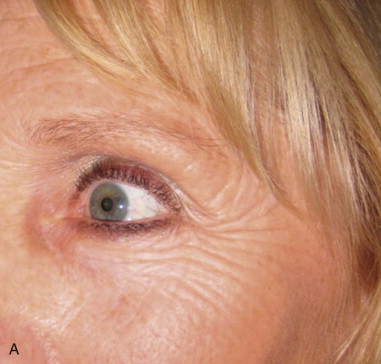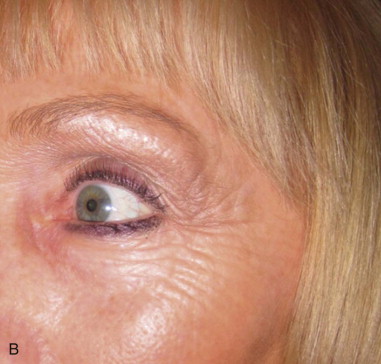Armamentarium
|
History of the Procedure
The history of brow lifting goes back nearly 100 years. Passot has been credited with the first description of forehead lifting, in 1919, using several transverse skin excisions of upper forehead skin. In 1926, Hunt described coronal and hairline excision. Others described undermining of the pericranium and resection of corrugator muscles in the years that followed. In the 1960s, other modifications, such as the pretrichial incision, were introduced. The first description of a “biplanar” approach to the temporal region was reported in the early 1970s. Flowers has been given credit for emphasizing the importance of proper brow positioning before upper eyelid surgery. In 1992, Isse introduced the concept of minimally invasive brow lifting via the endoscopic approach. Since then, a number of modifications have been made to both the open and the endoscopic approaches for forehead lifting.
History of the Procedure
The history of brow lifting goes back nearly 100 years. Passot has been credited with the first description of forehead lifting, in 1919, using several transverse skin excisions of upper forehead skin. In 1926, Hunt described coronal and hairline excision. Others described undermining of the pericranium and resection of corrugator muscles in the years that followed. In the 1960s, other modifications, such as the pretrichial incision, were introduced. The first description of a “biplanar” approach to the temporal region was reported in the early 1970s. Flowers has been given credit for emphasizing the importance of proper brow positioning before upper eyelid surgery. In 1992, Isse introduced the concept of minimally invasive brow lifting via the endoscopic approach. Since then, a number of modifications have been made to both the open and the endoscopic approaches for forehead lifting.
Indications for the Use of the Procedure
The main indication for brow lifting is to create a more youthful position for the brows. There are certainly other, secondary advantages of brow lifting, such as improving the appearance of forehead rhytids, relaxing the glabellar muscles (corrugator, procerus, and depressor supercilia), improving the appearance of crow’s feet, and enhancing the appearance of the upper eyelids (by improving dermatochalasia of the upper lids). An open, bright, and youthful appearance of the eyes and brows, especially in a female, is one of the first features of the face noticed in public ( Figure 134-1 ). It is important to note (as is discussed later in the chapter), in patients with upper eyelid dermatochalasia, the brows should be examined before eyelid surgery. Often, the real culprit in upper eyelid dermatochalasia is brow ptosis.


Limitations and Contraindications
Several limitations and contraindications must be considered when brow lifting is discussed with the patient. Many of the limitations depend on the particular type of brow lift. Open brow lifting can include coronal, pretrichial, midforehead, direct, and browpexy techniques. The only other method of brow lifting is the endoscopic approach. Coronal brow lifting can lengthen the forehead; therefore, it should not be used in patients with high hairlines (i.e., a long forehead). Direct brow lifting and browpexy can lift the brows only a few millimeters; these techniques are not indicated for severe brow ptosis. Pretrichial brow lifting is done in a subgaleal (preferred) or subcutaneous plane; this approach limits correction/transection of the procerus and corrugator muscles unless additional incisions are made. The endoscopic technique has an inherent learning curve and requires endoscopic instruments and monitors, which can be expensive. Endoscopic brow lifting is rather difficult to perform in patients with severe curvature of the forehead (sloping of the forehead in profile view).
Other limitations of brow lifting include the dilemma of performing a forehead lift in a bald patient or in one with a receding hair line. Some have advocated performing a pretrichial lift and actually lowering the hair-bearing scalp (inferiorly). Others recommend endoscopic brow lifting as the best choice for a bald patient (multiple small incisions rather than a coronal incision). It is important to place the brows in the ideal position before performing upper eyelid blepharoplasty.
Technique: Endoscopic Brow Lift
Step 1:
Preparation
The patient is placed in the supine position with the head in a small holder (e.g., a Mayfield or donut head device) to minimize movement. Protective eye shields (contact lenses) are placed. The supraorbital foramina/notches are marked. Standard prep solution is then used over the entire face and head. A local anesthetic with a vasoconstrictor is injected.
Step 2:
Incision
A midline incision approximately 2 cm long is made along the sagittal (median) plane within (1 cm) the hairline. The incision is taken all the way down through the pericranium to bone. Two similar incisions are made (paramedian) in a line parallel to the lateral limbus/canthus areas, again deep to bone. Next, two temporal incisions are made. These are slightly longer (2 to 3 cm) and are obliquely fashioned over the midtemple area within the hair-bearing scalp, perpendicular to a line from the nasal ala to the lateral canthus. These two incisions are deepened to the level of the deep temporal fascia. This creates a biplanar level of dissection (subperiosteal and suprafascial) ( Figure 134-2, A and B ).
Stay updated, free dental videos. Join our Telegram channel

VIDEdental - Online dental courses


